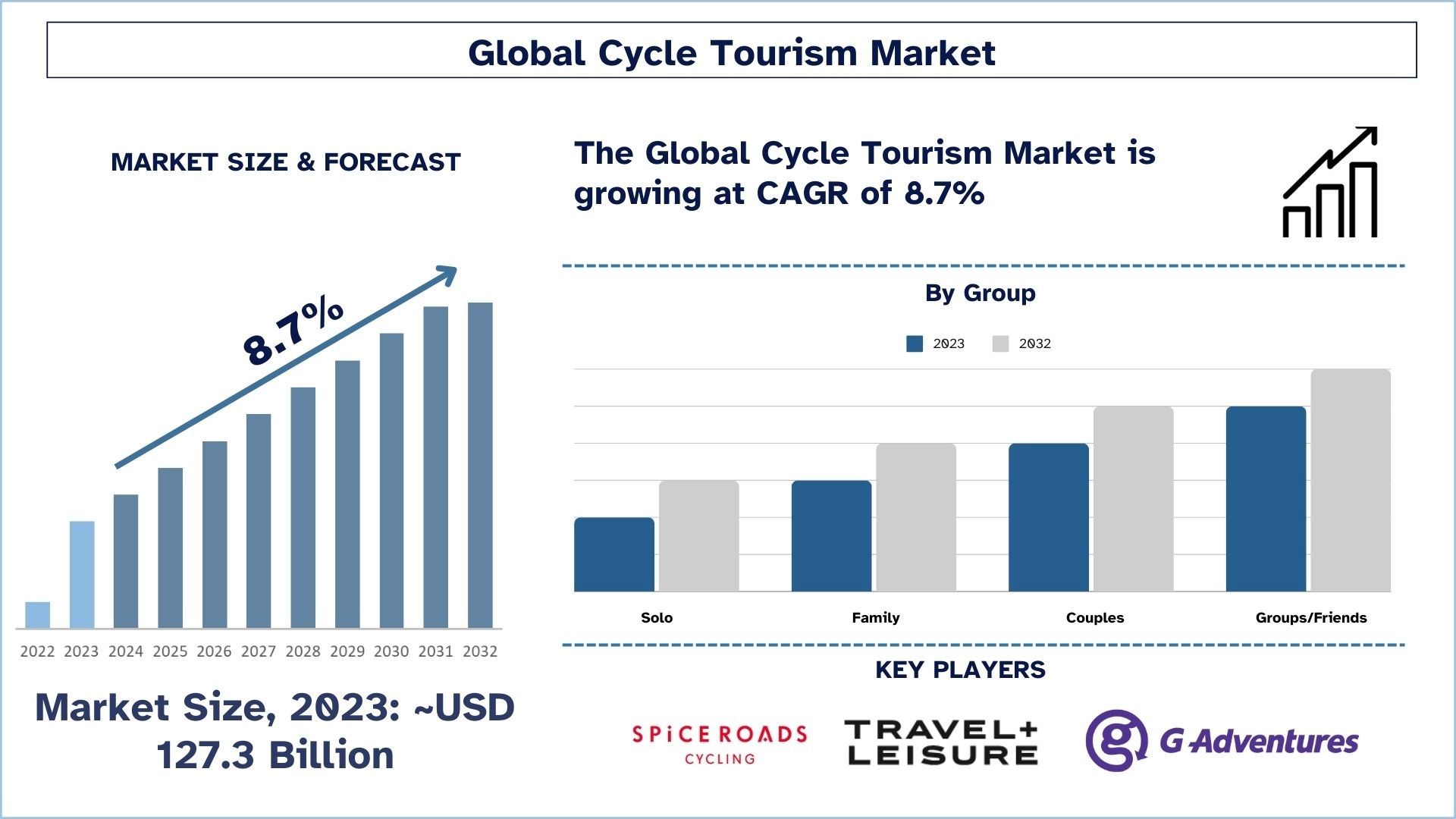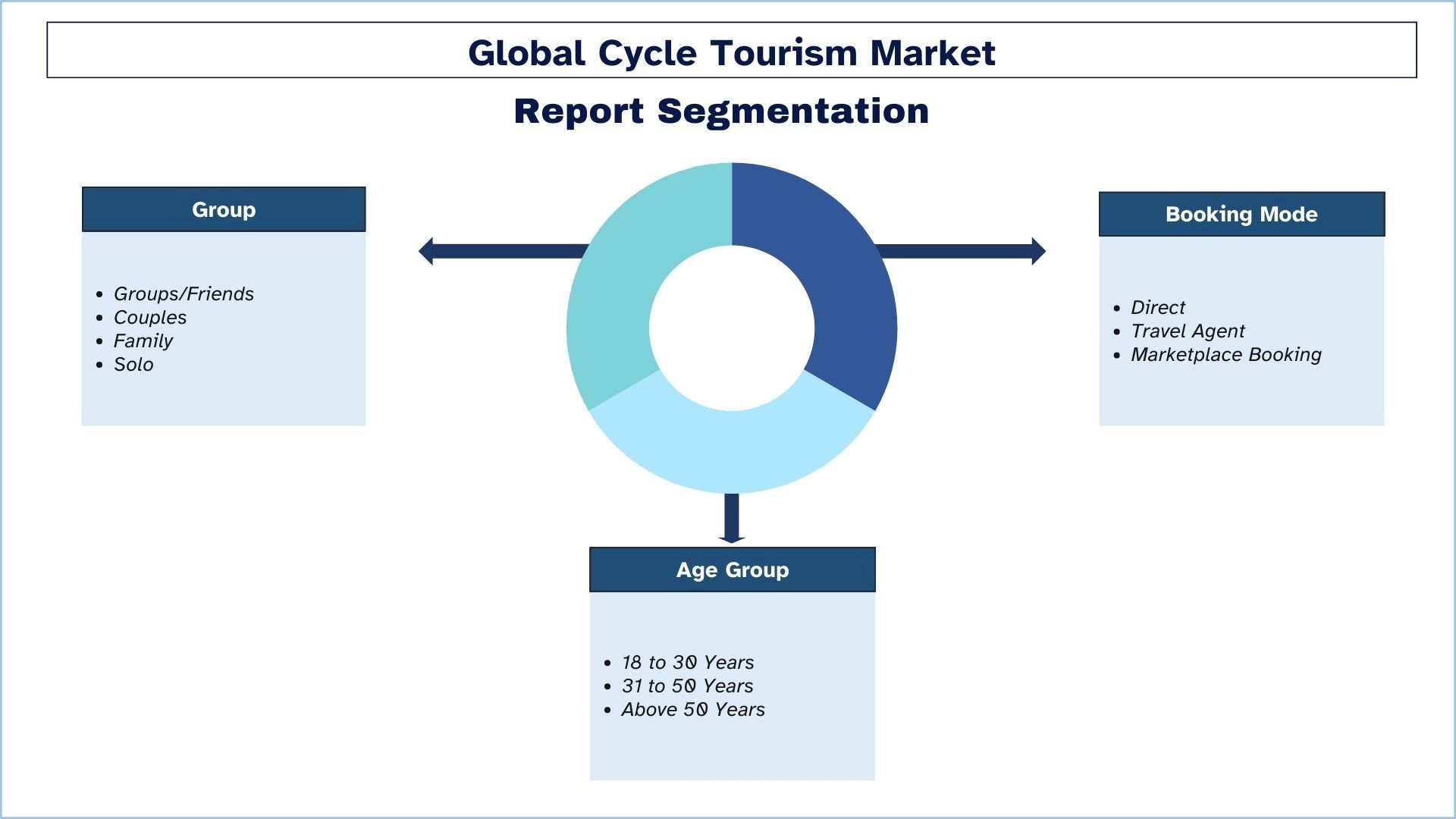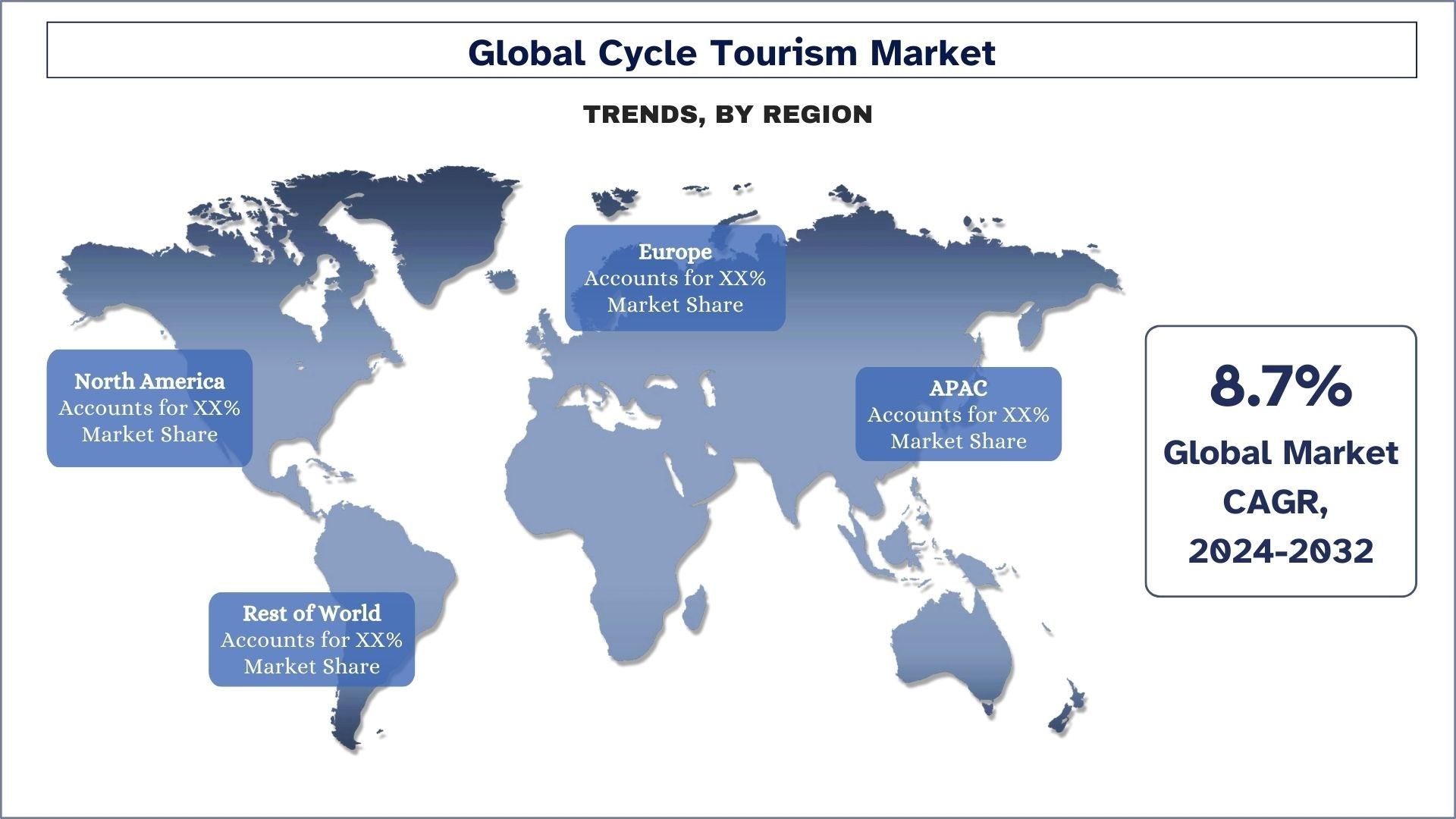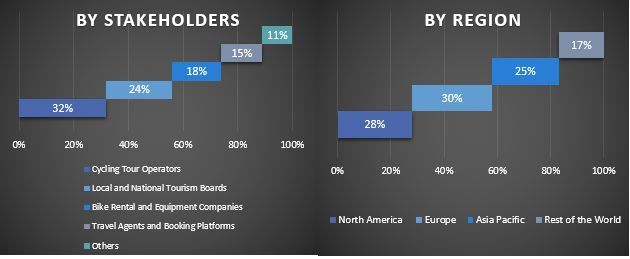- Accueil
- À propos de nous
- Industrie
- Services
- Lecture
- Contactez-nous
Marché du tourisme à vélo : Analyse actuelle et prévisions (2024-2032)
Accent sur les groupes (groupes/amis, couples, famille et solo) ; Mode de réservation (directe, agence de voyage et réservation via une plateforme) ; Tranche d'âge (18 à 30 ans, 31 à 50 ans et plus de 50 ans) ; et région/pays

Taille et prévisions du marché mondial du tourisme à vélo
Le marché mondial du tourisme à vélo était évalué à 127,3 milliards de dollars US en 2023 et devrait croître à un TCAC élevé d'environ 8,7 % au cours de la période de prévision (2024-2032) en raison de la sensibilisation croissante des touristes à leur empreinte carbone. Le cyclisme est écologique et s'aligne sur les valeurs du tourisme durable.
Analyse du marché du tourisme à vélo
Le marché du tourisme à vélo est en pleine expansion en raison de l'intérêt croissant pour les voyages durables, la remise en forme et le tourisme expérientiel, et il devrait croître encore plus à l'avenir en raison de la maturité du marché du tourisme à vélo, d'une plus grande sensibilisation à l'environnement, des avantages physiques et de la tendance à acheter des services de tourisme de détail en mettant l'accent sur les expériences locales. Le tourisme à vélo est un produit polyvalent offrant des services aux groupes et aux touristes individuels, et se présente sous la forme d'un voyage organisé pour les passionnés de vélo. Les leaders du marché diversifient leurs produits pour s'adapter aux différents types de population et aux préférences des jeunes générations, des familles, des voyageurs seuls et autres. Bien entendu, cette croissance du marché est influencée positivement par les applications web de réservation directe et les réseaux sociaux qui améliorent les vacances à vélo pour les utilisateurs de tout âge.
Tendances du marché mondial du tourisme à vélo
Cette section traite des principales tendances du marché qui influencent les différents segments du marché mondial du tourisme à vélo, telles que constatées par notre équipe d'experts en recherche.
Le segment des groupes/amis transforme l'industrie
Les groupes et les amis sont ceux qui ont tendance à dépenser de l'argent sur le marché du tourisme à vélo parce que ce sont des êtres sociaux qui aiment faire du vélo ensemble. Les gens aiment voyager en groupe parce que cela rend l'aventure plus excitante et que tout le monde se sent en sécurité, surtout lorsqu'ils choisissent ces itinéraires audacieux ou ces magnifiques sentiers. La plupart des organisations s'attaquent à ces problèmes en concevant des forfaits de groupe qui non seulement correspondent aux goûts des gens, mais rendent également les voyages plus économiques.

L'Amérique du Nord devrait croître à un rythme important au cours de la période de prévision.
Le marché nord-américain du tourisme à vélo devrait se développer dans les années à venir. L'Amérique du Nord possède de nombreux itinéraires magnifiques pour le cyclisme, notamment des routes côtières et des pistes cyclables, des parcs nationaux et d'autres itinéraires historiques pour le cyclisme rural, tant pour les loisirs que pour l'aventure. De nombreuses villes se dotent d'installations pour vélos, notamment des pistes cyclables et des voies cyclables sécurisées, ce qui améliore l'attrait du cyclisme en tant qu'activité de loisirs pour les touristes. De plus, grâce aux progrès des services de vélos en libre-service et à la disponibilité de vélos de location, tout touriste peut prendre un vélo et intégrer des vacances à vélo dans la tendance du tourisme à vélo dans la région.

Aperçu du marché mondial du tourisme à vélo
Le marché mondial du tourisme à vélo est concurrentiel, avec plusieurs acteurs mondiaux et internationaux. Les principaux acteurs adoptent différentes stratégies de croissance pour renforcer leur présence sur le marché, telles que les partenariats, les accords, les collaborations, les lancements de nouveaux produits, les expansions géographiques, ainsi que les fusions et acquisitions. Parmi les principaux acteurs du marché, on trouve SpiceRoads ; World Expeditions Travel Group Pty Ltd ; Travel + Leisure Co. ; Exodus Travels Limited ; Intrepid Group ; G Adventures ; Arbutus Routes ; Austin Adventures ; Himalayan Glacier ; Backroads
Couverture du rapport sur le marché mondial du tourisme à vélo
Attribut du rapport | Détails |
Année de base | 2023 |
Période de prévision | 2024-2032 |
Dynamique de croissance | Accélération à un TCAC de 8,7 % |
Taille du marché 2023 | 127,3 milliards de dollars US |
Analyse régionale | Amérique du Nord, Europe, APAC, Reste du monde |
Principale région contributrice | L'Amérique du Nord devrait dominer le marché au cours de la période de prévision. |
Principaux pays couverts | États-Unis, Canada, Allemagne, Royaume-Uni, Espagne, Italie, France, Chine, Japon et Inde |
Sociétés profilées | SpiceRoads ; World Expeditions Travel Group Pty Ltd ; Travel + Leisure Co. ; Exodus Travels Limited ; Intrepid Group ; G Adventures ; Arbutus Routes ; Austin Adventures ; Himalayan Glacier ; Backroads |
Portée du rapport | Tendances du marché, moteurs et contraintes ; Estimation et prévisions des revenus ; Analyse de la segmentation ; Analyse de l'offre et de la demande ; Paysage concurrentiel ; Profilage des entreprises |
Raisons d'acheter ce rapport :
L'étude comprend une analyse de la taille et des prévisions du marché, confirmée par des experts clés authentifiés du secteur.
Le rapport passe brièvement en revue la performance globale de l'industrie en un coup d'œil.
Le rapport couvre une analyse approfondie des principaux pairs de l'industrie, en se concentrant principalement sur les principales données financières de l'entreprise, les portefeuilles de types, les stratégies d'expansion et les développements récents.
Examen détaillé des moteurs, des contraintes, des principales tendances et des opportunités qui prévalent dans l'industrie.
L'étude couvre de manière exhaustive le marché à travers différents segments.
Analyse approfondie au niveau régional de l'industrie.
Options de personnalisation :
Le marché mondial du tourisme à vélo peut être davantage personnalisé selon les exigences ou tout autre segment de marché. De plus, UMI comprend que vous pouvez avoir vos propres besoins commerciaux, alors n'hésitez pas à nous contacter pour obtenir un rapport qui répond parfaitement à vos exigences.
Table des matières
Méthodologie de recherche pour l'analyse du marché mondial du tourisme à vélo (2024-2032)
L'analyse du marché historique, l'estimation du marché actuel et la prévision du marché futur du marché mondial du tourisme à vélo ont été les trois principales étapes entreprises pour créer et analyser l'adoption du tourisme à vélo mondial dans les principales régions. Une recherche secondaire exhaustive a été menée pour collecter les chiffres du marché historique et estimer la taille actuelle du marché. Deuxièmement, pour confirmer ces informations, de nombreuses conclusions et hypothèses ont été prises en compte. De plus, des entretiens primaires exhaustifs ont été menés avec des experts de l'industrie tout au long de la chaîne de valeur du marché mondial du tourisme à vélo. Pour l'hypothèse et la validation des chiffres du marché par le biais d'entretiens primaires, nous avons utilisé une approche descendante/ascendante pour prévoir la taille complète du marché. Par la suite, des méthodes de ventilation du marché et de triangulation des données ont été adoptées pour estimer et analyser la taille du marché des segments et sous-segments de l'industrie. La méthode détaillée est expliquée ci-dessous :
Analyse de la taille du marché historique
Étape 1 : Étude approfondie des sources secondaires :
Une étude secondaire détaillée a été menée pour obtenir la taille du marché historique du marché mondial du tourisme à vélo à travers des sources internes à l'entreprise telles que les rapports annuels et les états financiers, les présentations de performance, les communiqués de presse, etc., et des sources externes, notamment les revues, les actualités et articles, publications gouvernementales, publications de concurrents, rapports sectoriels, base de données tierce et autres publications crédibles.
Étape 2 : Segmentation du marché :
Après avoir obtenu la taille du marché historique du marché mondial du tourisme à vélo, nous avons mené une analyse secondaire détaillée pour recueillir des informations sur le marché historique et le partage pour différents segments et sous-segments pour les principales régions. Les principaux segments sont inclus dans le rapport, tels que le groupe, le mode de réservation, la tranche d'âge et la région. Une analyse plus approfondie au niveau des pays a été menée pour évaluer l'adoption globale des modèles de test dans cette région.
Étape 3 : Analyse des facteurs :
Après avoir acheté la taille du marché historique des différents segments et sous-segments, nous avons mené une analyse détaillée des facteurs pour estimer la taille actuelle du marché du marché mondial du tourisme à vélo. De plus, nous avons mené une analyse factorielle à l'aide de variables dépendantes et indépendantes telles que le groupe, le mode de réservation, la tranche d'âge et les régions du marché mondial du tourisme à vélo. Une analyse approfondie des scénarios d'offre et de demande a été menée en tenant compte des principaux partenariats, fusions et acquisitions, expansion commerciale et lancements de produits sur le marché mondial du tourisme à vélo.
Estimation et prévision de la taille actuelle du marché
Taille actuelle du marché : Sur la base des informations exploitables tirées des 3 étapes ci-dessus, nous sommes parvenus à la taille actuelle du marché, aux principaux acteurs du marché mondial du tourisme à vélo et aux parts de marché des segments. Tous les pourcentages de parts requis et les ventilations du marché ont été décidés à l'aide de l'approche secondaire mentionnée ci-dessus et ont été vérifiés par des entretiens primaires.
Estimation et prévision : Pour l'estimation et la prévision du marché, des pondérations ont été attribuées à plusieurs facteurs, notamment les moteurs et les tendances, les contraintes et les opportunités offertes aux parties prenantes. Après avoir analysé ces facteurs, les techniques de prévision pertinentes, c'est-à-dire l'approche descendante/ascendante, ont été appliquées pour parvenir à la prévision du marché 2032 pour différents segments et sous-segments sur les principaux marchés mondiaux. La méthode de recherche adoptée pour estimer la taille du marché englobe :
- La taille du marché de l'industrie, en termes de revenus (USD) et le taux d'adoption du marché mondial du tourisme à vélo sur les principaux marchés nationaux
- Tous les pourcentages de parts, les divisions et les ventilations des segments et sous-segments de marché
- Les principaux acteurs du marché mondial du tourisme à vélo en termes de types proposés. De plus, les stratégies de croissance adoptées par ces acteurs pour concurrencer sur le marché en croissance rapide.
Validation de la taille et de la part du marché
Recherche primaire : Des entretiens approfondis ont été menés avec les principaux leaders d'opinion (KOL), notamment les cadres de haut niveau (CXO/VP, chef des ventes, chef du marketing, chef des opérations, chef régional, chef de pays, etc.) dans les principales régions. Les résultats de la recherche primaire ont ensuite été résumés et une analyse statistique a été effectuée pour prouver l'hypothèse énoncée. Les informations issues de la recherche primaire ont été combinées aux résultats secondaires, transformant ainsi l'information en informations exploitables.
Répartition des participants primaires dans différentes régions
Ingénierie du marché
La technique de triangulation des données a été utilisée pour compléter l'estimation globale du marché et pour obtenir des chiffres statistiques précis pour chaque segment et sous-segment du marché mondial du tourisme à vélo. Les données ont été divisées en plusieurs segments et sous-segments après avoir étudié divers paramètres et tendances dans le groupe, le mode de réservation, la tranche d'âge et les régions du marché mondial du tourisme à vélo.
L'objectif principal de l'étude du marché mondial du tourisme à vélo
Les tendances actuelles et futures du marché mondial du tourisme à vélo ont été identifiées dans l'étude. Les investisseurs peuvent obtenir des informations stratégiques pour fonder leur discrétion en matière d'investissements sur l'analyse qualitative et quantitative effectuée dans l'étude. Les tendances actuelles et futures du marché ont déterminé l'attractivité globale du marché au niveau régional, offrant une plateforme au participant industriel pour exploiter le marché inexploité afin de recevoir l'aide d'un avantage de premier entrant. Les autres objectifs quantitatifs des études comprennent :
- Analyser les prévisions actuelles et la taille du marché mondial du tourisme à vélo en termes de valeur (USD). De plus, analysez les prévisions actuelles et la taille du marché des différents segments et sous-segments.
- Les segments de l'étude comprennent les domaines du groupe, du mode de réservation, de la tranche d'âge et des régions.
- Définir et analyser le cadre réglementaire de l'industrie.
- Analyser la chaîne de valeur impliquée avec la présence de divers intermédiaires, ainsi qu'analyser les comportements des clients et des concurrents de l'industrie.
- Analyser la taille actuelle et prévisionnelle du marché mondial du tourisme à vélo pour les principales régions.
- Les principaux pays des régions étudiées dans le rapport comprennent l'Asie-Pacifique, l'Europe, l'Amérique du Nord et le reste du monde.
- Profils d'entreprise du marché mondial du tourisme à vélo et stratégies de croissance adoptées par les acteurs pour maintenir le marché en croissance rapide.
- Analyse approfondie au niveau régional de l'industrie.
Questions Fréquemment Posées FAQ
Q1 : Quelle est la taille actuelle du marché mondial du tourisme à vélo et son potentiel de croissance ?
Le marché mondial du tourisme à vélo était évalué à 127,3 milliards USD en 2023 et devrait croître à un TCAC de 8,7 % au cours de la période de prévision (2024-2032).
Q2 : Quels sont les principaux facteurs de croissance du marché mondial du tourisme à vélo ?
Les villes encouragent le cyclisme en tant que solution pour réduire la congestion et la pollution urbaines, ce qui, par conséquent, stimule le tourisme à vélo à mesure que les gens adoptent le cyclisme comme mode de transport privilégié.
Q3 : Quel segment détient la plus grande part du marché mondial du tourisme à vélo par catégorie de groupe ?
La catégorie groupes/amis détient la plus grande part du marché mondial du tourisme à vélo par segment de groupe.
Q4 : Quelles sont les technologies et les tendances émergentes sur le marché mondial du cyclotourisme ?
L'essor des vélos électriques est une tendance significative, offrant l'accès au cyclisme à un public plus large et permettant aux touristes de parcourir de plus grandes distances avec moins d'efforts.
Q5 : Quelles régions dominent le marché mondial du tourisme cyclable ?
L'Amérique du Nord devrait dominer le marché au cours de la période de prévision.
Connexes Rapports
Les clients qui ont acheté cet article ont également acheté











